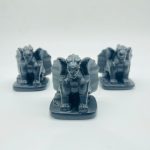Exploring the Dazzling Distinction
In the realm of precious stones, the terms “crystal” and “gem” often intertwine, fueling confusion and curiosity alike. While they share some similarities, these terms encapsulate vastly different characteristics and applications.

What’s a Crystal?
- A crystalline solid with a highly organized atomic structure
- Naturally occurs in regular geometric forms (e.g., cubes, pyramids, prisms)
- May exhibit transparency, translucency, or opacity
- Can be composed of various minerals, such as quartz, calcite, and salt
What’s a Gem?
- A mineral, mineraloid, or organic material that has been cut and polished
- Possesses exceptional beauty, durability, and rarity
- Typically transparent or translucent
- Used in jewelry, decorative objects, and industry
Key Differences
| Feature | Crystal | Gem |
|---|---|---|
| Structure | Highly organized atomic structure | Cut and polished |
| Form | Natural geometric shapes | Varied shapes, depending on cutting |
| Optical Properties | Can be transparent, translucent, or opaque | Transparent or translucent |
| Composition | Various minerals | Minerals, mineraloids, or organic materials |
| Applications | Energy healing (unproven), scientific instruments, electronics | Jewelry, decoration, industry |
Crystal vs. Gem: A Comparative Glance
| Characteristic | Crystal | Gem |
|---|---|---|
| Origin | Natural formation | Cut and polished from natural or synthetic materials |
| Shape | Geometric | Varied, depending on cutting |
| Transparency | Variable | Transparent or translucent |
| Hardness | Wide range (e.g., gypsum: soft; diamond: hardest known substance) | Relatively hard, but varies among different gems (e.g., opal: soft; ruby: hard) |
| Value | Varies based on size, clarity, and rarity | Determined by size, color, clarity, and cut |
| Applications | Energy healing (unproven), scientific instruments, electronics (e.g., quartz crystals in watches) | Jewelry, decoration, industry (e.g., diamonds in cutting tools) |
Common Mistakes to Avoid
- Assuming all crystals are gems: Not all crystals possess the beauty, durability, or rarity required to be considered gems.
- Confusing natural crystals with synthetic gemstones: Synthetic gemstones are lab-created to resemble natural gems and often have similar optical properties.
- Attributing healing properties to crystals: While some crystals are associated with certain energies, scientific evidence does not support their use as healing tools.
Tips and Tricks
- Use a loupe or microscope: Examine crystals and gems for clarity, inclusions, and surface flaws.
- Consider the gemological properties: Understand the hardness, refractive index, and specific gravity of different gems to aid in identification.
- Seek professional advice: Consult a gemologist for expert guidance on purchasing and maintaining gemstones.
FAQs
1. Can you cut and polish a crystal into a gem?
Yes, but the crystal must possess the necessary transparency, hardness, and durability.
2. What are some common misconceptions about crystals?
Crystals are not scientific healing tools, and not all crystals are valuable or collectible.
3. How do you determine the value of a gem?
The value of a gem depends on various factors, including size, color, clarity, cut, and rarity.
4. What are some of the most valuable gemstones?
Diamonds, rubies, emeralds, and sapphires are among the most sought-after and expensive gemstones.
5. What is the difference between a gemstone and a gem-quality stone?
A gemstone has exceptional optical properties and durability, while a gem-quality stone falls short of these standards but still has decorative value.
6. What is a mineraloid?
A mineraloid is a naturally occurring substance with a crystalline structure but does not meet the strict chemical composition requirements of minerals. Some gemstones, such as opal, are mineraloids.
Crystal vs. Gem: A Spark of Inspiration
The distinction between crystal and gem highlights the vast diversity and applications of precious stones. As we continue to explore these dazzling creations of nature and science, they continue to spark our creativity and imagination.
Table 1: Crystal Energy Applications (Unproven Claims)
| Crystal | Supposed Energy |
|---|---|
| Amethyst | Peace, tranquility |
| Clear quartz | Healing, energy amplification |
| Rose quartz | Love, relationships |
| Selenite | Purification, protection |
| Citrine | Abundance, prosperity |
Table 2: Gem Value by Rarity (Carat Prices)
| Gemstone | Carat Price Range (USD) |
|---|---|
| Diamond | $7,000 – $15,000 |
| Ruby | $10,000 – $25,000 |
| Emerald | $5,000 – $12,000 |
| Sapphire | $3,000 – $10,000 |
| Opal | $100 – $5,000 |
Table 3: Synthetic vs. Natural Gemstones
| Feature | Synthetic | Natural |
|---|---|---|
| Origin | Lab-created | Natural formation |
| Chemical Composition | Same as natural | Same as natural |
| Crystal Structure | Identical to natural | Identical to natural |
| Optical Properties | Similar to natural | Similar to natural |
| Value | Lower than natural | Higher than synthetic |
Table 4: Common Crystal Applications
| Application | Crystal |
|---|---|
| Jewelry | Clear quartz, amethyst |
| Scientific Instruments | Quartz crystals |
| Electronics | Gallium arsenide (GaAs) |
| Energy Healing | Rose quartz, amethyst (unproven claims) |
| Decorative Objects | Calcite, fluorite |
Gem-sparking Adjectival Aptitude
To generate new applications for crystals and gems, consider these creative adjectives:
- Crystalline – incorporating the crystalline structure
- Gematic – pertaining to the beauty and rarity of gems
- Scintillating – exhibiting a sparkling brilliance
- Prismatic – producing a spectrum of colors
- Iridescent – displaying changing hues




























